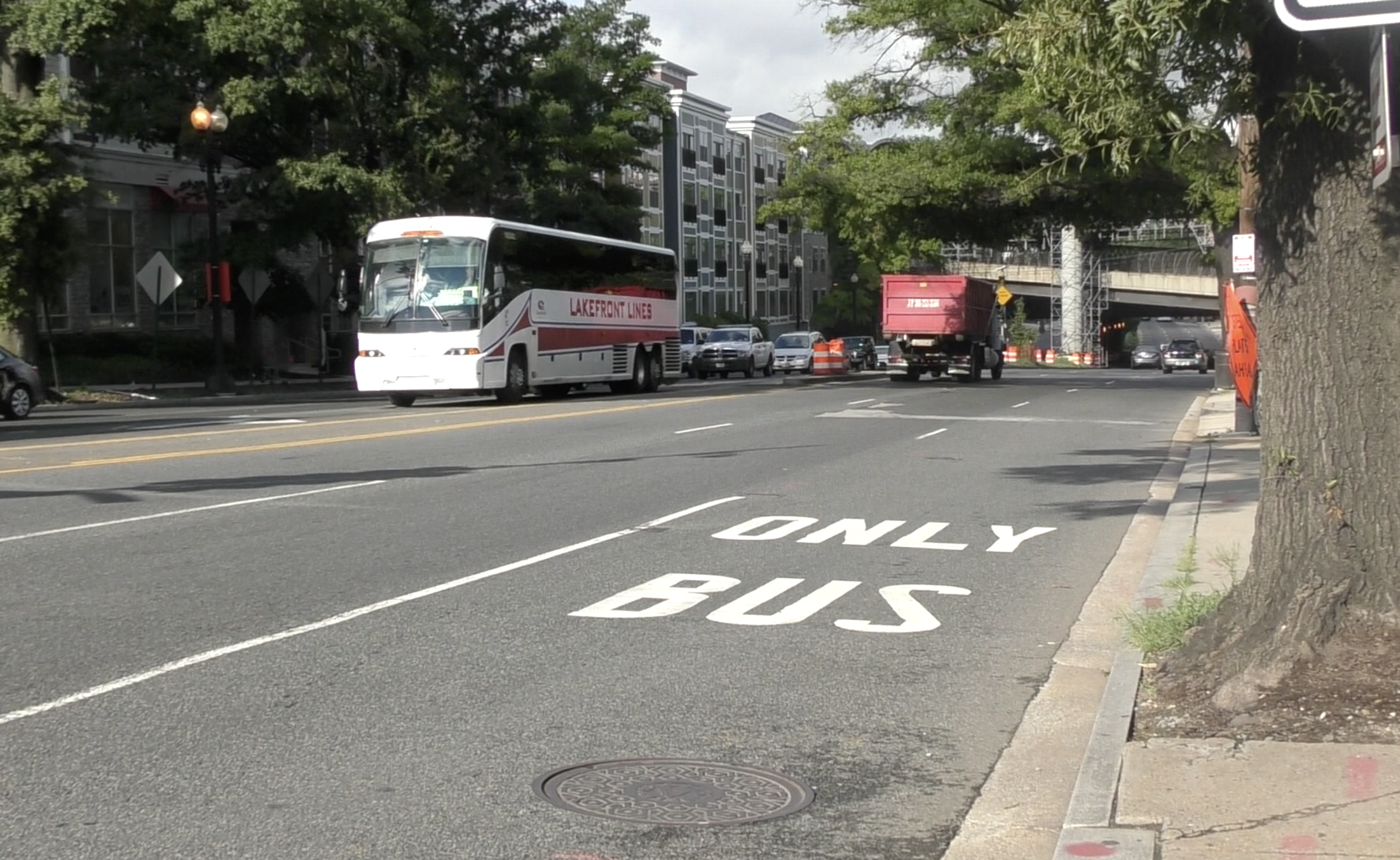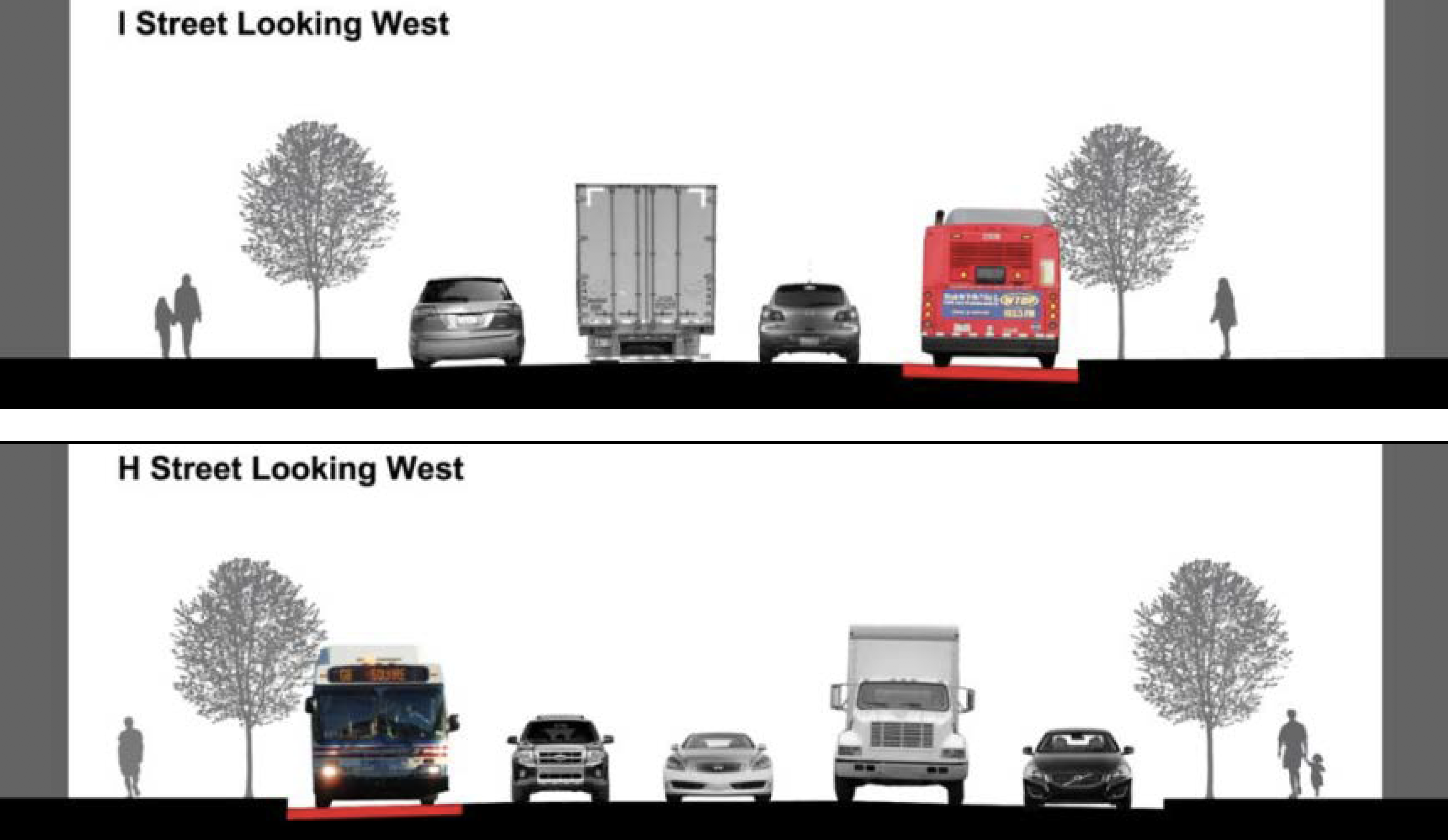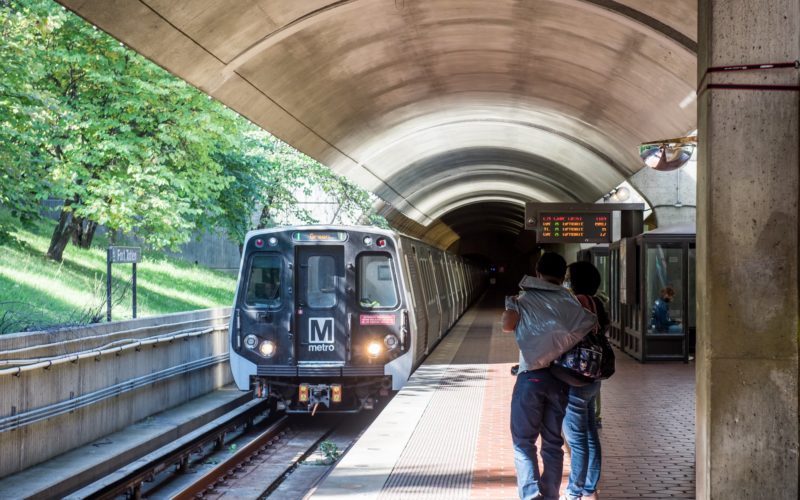
DDOT will apply lessons learned from last year's Rhode Island Avenue bus lane to new lanes on H & I St.
The bus lanes will coincide loosely with the shutdown of six stations on the DC Metro Blue and Yellow lines, with the 11Y bus, which runs on both H and I Street, expected to absorb many of the riders affected by Metro’s maintenance work.
But even under normal circumstances, H and I Streets need bus lanes. They are two of DC’s busiest bus corridors, peaking at 70 buses an hour and serving routes that carry 20% of MetroBus ridership. The anticipated pressure from the Metro station shutdowns created a strategic opportunity for DDOT to add bus priority to the streets.

Cross section of the new street configuration
“Usually during the rush hour, these lanes are available as travel lanes,” says project co-lead Raka Choudhury. “Hopefully, dedicating the lanes for buses will make it more attractive for people to take transit instead of driving during the shutdown.”
Temporary bus lanes are not an entirely new concept for the District. Last summer, DDOT tested out a “pop-up” bus lane along Rhode Island Ave during the closure of Metro’s Red Line. The results were mostly disappointing. Without red pavement, adequate signage, or sufficient enforcement, drivers routinely drove and parked in the lanes, forcing bus riders to sit in general traffic.
But the experience did prove educational. DDOT is approaching this bus lane iteration with a much better understanding of what’s needed for success. Because the agency jumped at the chance to try again, they are ready to transform the experience of riding the bus for tens of thousands of people.
This time around, DDOT planners recognize that the H and I Street bus lanes need to be more visible to drivers. The lanes will be painted bright red and blanketed with signs advertising their presence. Because of lane width constraints, DDOT has opted against using cones or other protective barriers to keep drivers out.
In lieu of a barrier, vigilant enforcement of bus lane blockers will be key. According to Choudhury, DDOT is coordinating with myriad city agencies to conduct enforcement. DDOT staff trained as traffic control officers, and the Metropolitan Police Department, Department of Public Works, and Department of For Hire Vehicles will all be participating in the effort.
The H and I Street lanes are the latest entry in the growing practice of “tactical transit.” Though still relatively rare, a number of US transit agencies are testing out nimble implementation methods, using low-cost materials like paint and signage to increase the speed and reliability of bus trips practically in a matter of days.
Where they’ve been deployed, these bus lanes have proven marvelously effective at improving transit speeds and building support for longer-term street changes. Rather than devoting months to outreach that never produces a satisfying consensus, temporary lanes can enable agencies to showcase the benefits of a proposal in practice, then monitor and tweak if necessary.
The now-famous “pop-up” bus lane in Everett, outside Boston, repurposed a parking lane into a bus lane overnight, using implementation as a substitute for outreach. Once riders and drivers saw the benefits of the lane, a return to the status quo was inconceivable. Not to be outdone by Everett, the City of Boston and the nearby suburb of Arlington also piloted bus lanes that later became permanent.
How will DDOT determine whether the bus lanes on H and I Street stick around? “We’ll be looking at four metrics along the corridor – safety, mobility, reliability, and compliance – to see whether they improve,” said Choudhury.
“Right now this corridor isn’t working well for anyone – including drivers,” added Megan Kanagy, co-project lead at DDOT. “We plan to be proactively monitoring the performance of the H and I Street lanes, and are continuing the pilot into the fall to see how it performs when school and Congress are back in session.”
In a city where bus lanes have taken nearly a decade to implement, Kanagy and Choudhury hope this tactical approach can serve as a new model for DDOT. “Moving forward, we hope to deliver two types of bus projects – these shorter, tactical interventions, and the more involved corridor projects,” says Kanagy. “We are also actively thinking about how to organize staff and streamline project delivery processes to shorten time frames for big projects like 16th Street.”
 On the Brink: Will WMATA’s Progress Be Erased by 2024?
On the Brink: Will WMATA’s Progress Be Erased by 2024?
The experience of being a WMATA rider has substantially improved over the last 18 months, thanks to changes the agency has made like adding off-peak service and simplifying fares. Things are about to get even better with the launch of all-door boarding later this fall, overnight bus service on some lines starting in December, and an ambitious plan to redesign the Metrobus network. But all of this could go away by July 1, 2024.
Read More What’s Going on With Transit Service at the Seven Highest Ridership U.S. Cities? DC Edition
What’s Going on With Transit Service at the Seven Highest Ridership U.S. Cities? DC Edition
Mechanical problems with the 7000-series train cars and lapsed rail operator certifications have caused rail service levels on WMATA to plummet, but the agency is running 100% of pre-pandemic bus service.
Read More